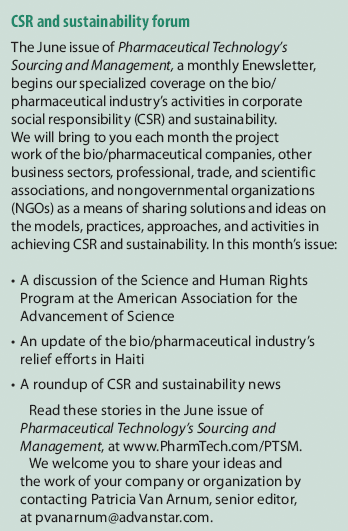Leveling the Compliance Playing Field
The author suggests industry may need a NATO-type organization to even out inspections.
Scenario A
Let's say you have a production facility in Trenton, San Francisco, or Boston—really anywhere in the United States. Your company's drug-development efforts have been successful, and it's time for the US Food and Drug Administration to conduct a pre-approval inspection. Your company has made careful preparations. One day, two FDA investigators arrive at the door of the facility. Because the agency has not inspected your facility in recent years, the investigators announce that they plan to spend two weeks on site. The investigators are fair and thorough. They ask to see:
- Your written procedures, which you quickly provide
- Your logs for deviations, out-of-specification results, rejected batches, change control, complaints, and stability failures. They request trend reports for environmental monitoring and for the water system. Batch records and other product-specific documents are also requested. You provide these logs and records promptly and, using risk-management principles, sort them into piles from the most critical to the most minor.
- Finally, the investigators ask to see your records for all the critical lots, which you promptly provide.
Paul Larocque
The investigators scan the documents for any red flags. Every few minutes, they ask for clarification of various points; responses are provided immediately so that the investigators can move on quickly.
During the exit interview, your company receives a Form 483 containing 12 observations, none of which are deemed critical (i.e., related to fraud) but several will take significant time and resources to correct. (Once corrected, FDA will consider granting approval for the product that was reviewed.) Your company makes the required adjustments and months later, the product is approved and launched.
Scenario B
Instead, let's say your production facility is located in continental Europe, Asia, or Mexico—any non-English-speaking country. Your company's drug-development efforts again have been successful. It's time for the FDA pre-approval inspection. The agency contacts you weeks in advance to schedule the inspection with one investigator, who is scheduled to be on site for five days. Your company makes careful preparations, including training the staff about the conduct of FDA inspections. On the agreed day, the FDA investigator arrives at the door of the facility.
The investigator asks to see the same documents as noted in Scenario A, which you provide promptly. As required, the documents are written in the local language. A handful of the most common standard operating procedures have been translated into English, and these too are provided to the investigator. However, the logs, complaint records, trend reports, product-specific documents, investigations, and change-control records are all written in the local language.
The investigator tries to scan each document for red flags but, not being proficient in the local language, frequently asks for explanations about what is written. The FDA investigator would like to ask the analyst who generated the data (or the operator who conducted the step) what happened, but neither person speaks English. The host, who is head of quality assurance, speaks reasonable but halting English and acts as an interpreter.
Ultimately, the investigator ends up auditing far fewer documents than he would have in an English-speaking location. At the exit interview, your company receives a Form 483 containing three observations, none of which are deemed critical. Within about two weeks, the company addresses the observations, FDA approves the product, and the product launches.
Finding a solution
We have seen both scenarios among our clients. Is this a level playing field? Is it in a company's best interest to relocate its production to a foreign, ideally non-English speaking, country to attract less FDA scrutiny? Because of lower compliance costs, the company's cost of production will also be lower, in addition to any other related lower costs based on the local economy.
Considering the global nature of the pharmaceutical business and the merits of free trade, global inspection standards are needed and should be uniformly enforced. The current supply chain has become so long that breaches are occuring more frequently, with no end in sight. Unfortunately, a long supply chain can lead to fragmented inspection scrutiny. Should regulators discourage such complicated production schemes under the justification that they are too risky and too difficult to control? Supply-chain breeches cast doubt on the industry, harm its credibility, and reduce consumer confidence in products—just look at the recent consumer angst over the H1N1 vaccine.
The International Conference on Harmonization (ICH), the Global Harmonization Task Force (GHTF) for medical devices, and the pharmacopeia have made good progress on establishing global standards. But global standards are only as good as global enforcement, because too much profit is available to those who cut corners. FDA has a major, but not all-encompassing, global inspection program. The Europeans have a significant foreign inspection program.And other countries perform some foreign inspections, but is this enough? Consider the following:
- Perhaps the countries setting the global standards also need to set global enforcement standards backed with adequate inspection resources
- Perhaps each country should contribute resources for enforcing compliance in proportion to its size
- Similar to the way ICH sets harmonized standards for product applications, perhaps the organization could also agree on the depth and breadth of global inspections
- Perhaps all inspectors from around the world should have a standard amount of time to spend on site, ask the same questions, request (and be able to understand) the same number of documents, and arrive at similar conclusions based on what they have seen—would this require a global inspectors' training program?
- Perhaps all good manufacturing practice documents should be required to be in the local language and in one of a handful of major world languages that would be used by the majority of inspectors.
There is precedent for developed countries to cooperate on enforcement—for example, to protect global human rights. The UN and the North Atlantic Treaty Organization oversee such collaboration. How about an ICH Inspectorate?
Paul Larocque is president of Acerna Inc. in Ontario, www.Acerna.ca, paul.larocque@acerna.ca.



